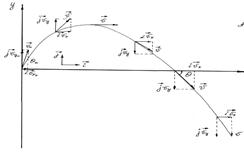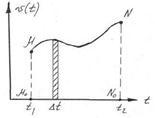
CATEGORIES:
BiologyChemistryConstructionCultureEcologyEconomyElectronicsFinanceGeographyHistoryInformaticsLawMathematicsMechanicsMedicineOtherPedagogyPhilosophyPhysicsPolicyPsychologySociologySportTourism
Projectile Motion
An example of curved motion with the constant acceleration is the projectile motion. This is the two-dimensional motion of a particle thrown obliquely into the air. If we choose a reference frame with the positive y-axis vertically upward, we may put
 . (3.8)
. (3.8)
Let us further choose the origin of our reference frame to be the point at which the projectile begins its flight

Figure 3.2
The velocity at t = 0, the instant the projectile begins its flight, is  , which makes an angle
, which makes an angle  0 with the positive x-direction. The x – and y-components of
0 with the positive x-direction. The x – and y-components of  are then
are then
 . (3.9)
. (3.9)
The horizontal velocity component retains its initial value throughout the flight, so that
 . (3.10)
. (3.10)
The vertical component of the velocity will change with the same in accordance with vertical motion with the constant downward acceleration
 (3.11)
(3.11)
so that
 . (3.12)
. (3.12)
The magnitude of the resultant velocity vector at any instant is
 . (3.13)
. (3.13)
The angle  that the velocity vector makes with the horizon at that instant is given by
that the velocity vector makes with the horizon at that instant is given by
 (3.14)
(3.14)
The x-coordinate of the particle’s position at any time is
 . (3.15)
. (3.15)
The y-coordinate is


 (3.16)
(3.16)
 (3.17)
(3.17)
 (3.18)
(3.18)
 (3.19)
(3.19)
Let us suppose that we know the change of acceleration with time, i.e., the function
 , (3.20)
, (3.20)
then the velocity of the particle at the instant t may be easily found
 . (3.21)
. (3.21)
The less  is the more accurate will be the calculation, that is why the value of
is the more accurate will be the calculation, that is why the value of  must be taken infinitesimal. In this case the sum
must be taken infinitesimal. In this case the sum  is written as an integral
is written as an integral
 . (3.22)
. (3.22)
If the body moves with variable acceleration the path covered by it is defined in the same way.
 . (3.23)
. (3.23)
Fig. 3.3 gives a graphical explanation of this calculation. This path is represented by the area 

Figure 3.3
Date: 2015-01-12; view: 1336
| <== previous page | | | next page ==> |
| Lecture 3. Constant Acceleration | | | Circular Motion of a Particle |